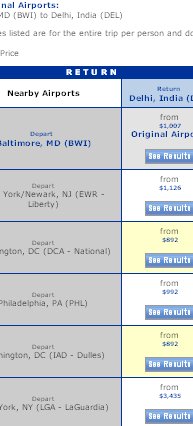Past one week has been kind of a roller coaster ride for me. It started with a travel plan and ended with no travel at all, with a number of lessons learned along the way. News of a family member’s death in India came on last Friday night. Within minutes I was online looking for air tickets to India.
There are two things about air ticket pricing that I fail to understand:
1. A ticket from B to C can be more expensive than a ticket from A to C with the same connecting flight at B
So, I have to start my journey in Washington DC region. Any one of the airports is fine – Baltimore-Washington, Washington-Dulles, or Reagan-National, even Philadelphia works. Since there is no direct flight from any of these airports to Delhi, the options are either to fly via Europe, or to take a flight to another US airport (Newark or New York) and take a direct flight from there. The advantage with a stopover in Europe is that your travel gets roughly equally divided into two 8 hour flights, as against a 1 hour and a 14  hour flight if your connection is within US. Another option that travelers in DC region like to use is to drive to Newark and take a direct flight from there. That is an option I prefer too, for reasons I will explain in another post, but look at the pricing structure you sometimes see. I did a fresh search today, and the prices are in the graphic on the right:
hour flight if your connection is within US. Another option that travelers in DC region like to use is to drive to Newark and take a direct flight from there. That is an option I prefer too, for reasons I will explain in another post, but look at the pricing structure you sometimes see. I did a fresh search today, and the prices are in the graphic on the right:
While the flight from Newark to Delhi is $1126 (before taxes), Baltimore-Newark-Delhi is a good $119 cheaper, and Washington-Newark-Delhi is $234 cheaper. Can someone explain this? Do they have some kind of a quota from these cities? But still, you ultimately board the same flight from Newark. The economics of 8+2=9 is understandable, but 8+2=7? It is not always like this, but it is not at all hard to find such fare structure.
So, I buy the ticket for Washington-Newark-Delhi route. Who would pass up the $234 difference? The travails I went through later may explain some of the madness, but from the airline’s side this is not understandable.
2. If you hold a ticket from A to B to C, and would like to skip A to B, the airline won’t let you do that
When most economy travelers buy tickets, the tickets come with a rider “any changes will cost you money”. OK, understood. You change the date of journey, you pay money. You change the origin or destination, you pay money. You reroute your journey, you pay money. But if you take an alternative means of transport to travel to B and skip the A to B sector, why can’t the airline mark that sector as used, perhaps sell it to someone else, and let you take the second sector without charging you. You are not making the airline change anything at all, except they have an empty seat on sector A to B, that has been paid for and can potentially be sold again. No, says the airline. If you skip the first, it will be a change, and you may end up paying hundreds of dollars. Yes, if I decide on the day of departure to drive to Newark, the airline will charge me a change fee and charge me that day’s price from Newark, which can be as much as twice. Now, if the eccentricity number 1 above can be somehow explained, it makes some sense — the airline will say you booked the longer cheaper price and now you want to use the shorter costlier itinerary. The problem is, even if you have paid much more for the longer itinerary, still most airlines won’t let you skip a leg.
Last month, a friend was taking a flight with itinerary Pittsburgh-Philadelphia-Europe-Delhi. Since the traveler was closer to Philadelphia than to Pittsburgh on the day of travel, she tried to tell the airline she wanted to take the flight from Philadelphia and skip the first leg, but no amount of requesting the airline would make them allow her to do that. Can anyone in the airline industry explain? Can’t they allow an online check-in where the traveler can mark their choice to skip the leg? That way, the airline has no additional work either.
There is more to come in this series of Air Travails, so keep coming back.
Air Travails 1: Eccentricities of Air Tickets
by
Tags:
Leave a Reply